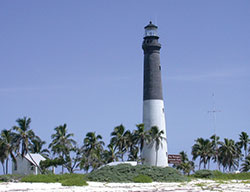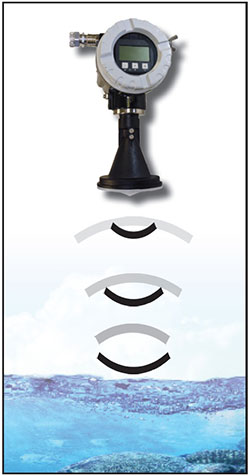Sea Level Rise at Dry Tortugas National Park
For Centuries, a vast network of coastal lights—like the ones that still tower over Garden and Loggerhead Keys—safely guided mariners away from shoals, reefs, and other potential hazards. In the present, we routinely rely upon weather radars, depth finders, satellite radios, and GPS to guard against peril as we navigate the vastness of the ocean. In the years ahead, however, rising sea levels will pose a significant challenge for low-lying coastal areas like the Dry Tortugas. In response, an effort is currently underway to build a new network of instrumentation that may help deliver us from new dangers ahead.
A Climate in Flux; A Troubled Coast 
Our changing climate could drastically transform coastal areas in the coming century. Higher concentrations of atmospheric carbon dioxide may alter ocean chemistry to the detriment of some shellfish and plankton.
Higher air temperatures and changing patterns of precipitation may change the composition and seasonal cycles of wildlife along the shore, including sea turtles, fish, and migratory birds. And a warming ocean could greatly hinder the survival of imperiled coastal species, including several types of coral found in the shallow waters of the Dry Tortugas.
But for coastal areas of only slight elevation, the most serious consequence of climate change will likely be sea level rise. A tide gauge operating on Key West since 1913 provides one of the longest instrument records in our hemisphere. Since that time, it has recorded an average of 2.36 mm of rise per year—a total of more than 9 inches over the past century. More importantly, scientific models suggest we are likely to experience an accelerated rate of sea level rise in the years ahead. Much like a spyglass might have helped mariners survey the waters ahead, tide gauges help bring long-term changes to our oceans into greater focus.
Variability & Local Conditions
Though the global average sea level is clearly rising, the magnitude of rise is not equal across all areas. Observed changes to relative sea level can be highly variable due to the influence of prevailing ocean currents, the rise and fall of land masses, or the compaction of coastal sediments. Differences in the rate and magnitude of rise can be observed not only across continents but also at much finer regional scales.
Although the data available from the Key West tide gauge is a good proxy for sea level rise in South Florida, the islands of the Dry Tortugas are located well over 70 miles away. Effective management of the park’s unique resources will require a more nuanced understanding of site-specific trends over time, and the park has recently installed a new instrument to meet this ongoing need.
Gauging the Tides
A new tide gauge was recently installed on Garden Key, which will record reliable sea level data at Dry Tortugas for the first time.
The sensor selected for this task works on microwave technology, measuring the distance to the water by recording the time it takes a signal to go from the sensor to the water surface and return. This type of instrument is well suited for the Garden Key site since it is capable of accurately determining sea level even in the presence of waves, seagrass, or large numbers of fish just below the surface.
This type of sensor is considered very stable and has been used extensively at other tidally influenced water level stations around the globe.
Since the recording method is based on time, the sensor is also extremely stable, capable of delivering accurate values with very little maintenance for months to years. Information from the sensor is delivered via satellite to an NPS database where the data are reviewed for accuracy and further shared via the internet.
The addition of the new tide gauge at Dry Tortugas is part of a larger, national effort. Similar instruments are being installed at national park sites across the country to provide locally relevant data for long-term park planning.
What's at Stake?
Dry Tortugas National Park contains numerous resources of impressive beauty and significance. Because these treasures exist almost at the waterline, rising seas are likely to have a significant impact on their conservation over time.
Thus far, the wildlife of the area has managed to adapt to changing conditions, and the bricks and mortar of Fort Jefferson have somewhat withstood the assaults of wind and wave. But properly stewarding the park into the future will require diligently watching the surrounding waters over time. In the years ahead, the humble tide gauge may guide us more brilliantly than the flashing beacon of Loggerhead Light.
A special thanks to the National Park Service for the information and pictures included in this application note. National Park Service U.S. Department of the Interior Dry Tortugas National Park P.O. Box 6208 Key West, FL 33041 Please visit for additional information on our products.

Additional Blog Posts of Interest:
Alaskan Flood Waters Fail to Put a Dent in YSI Water Quality Sonde
Real-Time Water Quality Monitors Gauge Florida Lagoon's Health
Stormwater Monitoring Guide - 6 Steps to Consider
Real-Time Stormwater Monitoring System for NPDES Compliance